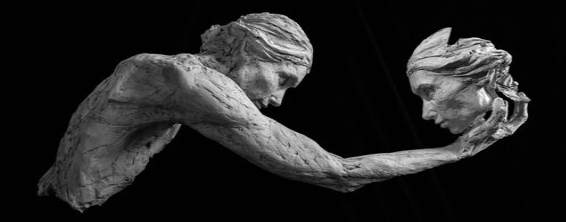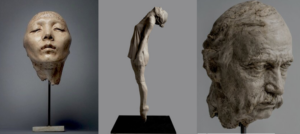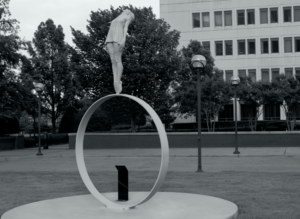When it comes to contemporary art forms, modern sculpture is among the ranks of the Country’s most popular gallery and public installations. It’s generally practiced by accredited artists known through local art communities. However, before we delve into examples of modern sculpture with Art Guide’s latest Feature Artist; let’s first consider reliance, if any, on the traditions of this art form. As a rule, art curators and professors consider contemporary sculpture to be the practice of three-dimensional works that first began in the 1950’s and has since progressed beyond its boundaries of stone, wood and metal. Today’s art Curators encourage any arrangement or variety of materials used to assemble a unique construct of art.
An Asymmetric Approach
Art Guide’s Feature Artist, Sculptor Erin McCarthy, pays tribute to the historic tradition of figurative compositions, while using current material methods for Resin and bronze. Her research and personal vision first began through years of training and travel to international art programs and residencies. As was once common practice of the early masters; Erin begins her work with a group of rough sketches to establish a three-dimensional form. However, she limits this early design step by moving directly to the interaction and study of a live model. Focused first on the accuracy of human proportions and scale, she’s then free to plan the figure’s kinetic sculptural energy.
McCarthy’s professional trademark of an off-balance composition is developed through the progression of her work method and unique innovative design process. Due to the flexibility of clay and Resin as shaping materials, Erin is able to mold uneven weight distributions to create physical gestures of movement. This careful styling of the figure often appears in tension, so as to render the subject at a visual tipping point. Through implied movement and a keen insight for composition, Erin’s Resin and bronze sculptures result in deeply sensitive, professional works of the human form.
Shift in Perspective
Born near the Boston area, Erin McCarthy first began a professional career in the beauty industry, however after studying under renowned makeup artists in Paris, she shifted her attention to academic works of sculpture. Through two decades of study, Erin has traveled the globe for training courses, while also exhibiting in Italy, England, Austria and the United States. She continues to manage a professional art career that holds a rich, prolific body of work.
At her website biography, Erin notes that she; “…decided to immerse herself in the discipline of realistic sculpture and spent three years, 2011 – 2014, at the Florence Academy of Art where she diligently studied the classical methods of the masters and realized her true passion for sculpture of the human form. Her time at the academy focused on developing technique through accuracy of proportions and gesture. Her work has since evolved to focus on anatomy as a result of a compulsory courses in Advanced Human Anatomy while in Italy. The benefits of studying anatomy through dissection enabled her to sculpt with a greater knowledge and tactile approach.”
A Community Influencer
Upon graduation from the Florence Academy, Erin was selected to serve as Artist in Residence at the prestigious Galerie Schloss Weispach in Hallein, Austria. During her residency Erin interacted closely with academics and locals, from that experience she realized the influence of art on a community, which gave her a deeper awareness and led to her passion for public art.
Erin’s lifelike work was honored in 2019 by the prominent Portrait Society of America and awarded first place in the annual portrait competition for the bust of her father entitled Simple Man. Her resume to date includes professionally commissioned busts, commercial figurative conceptual pieces and community public sculptures.
Visit Erin McCarthy’s sculptural works at: https://www.erinmccarthysculpture.com/
“You have to let the viewers come away with their own conclusions. If you dictate what they should think, you’ve lost it.” Maya Lin, sculptor
> This week the Art Guide Team will be in Washington DC for the commemoration of Sabin Howard’s bronze sculpture, ‘A Soldier’s Journey,’ World War l Memorial, on Pennsylvania Ave. Don’t miss our review of this life size thirty-eight figure work, considered a masterpiece in American sculpture.





